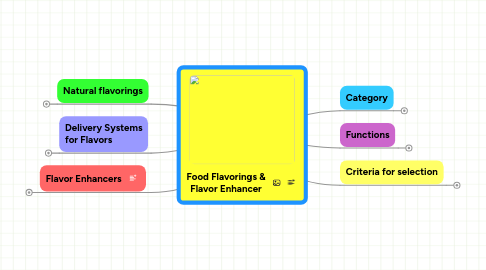
1. Natural flavorings
1.1. Sources
1.1.1. Herbs
1.1.1.1. Basil
1.1.1.2. Mint
1.1.1.3. Thyme
1.1.2. Spices
1.1.2.1. Conventional spices
1.1.2.1.1. Anise
1.1.2.1.2. Cinnamon
1.1.2.1.3. Capsicum (pepper)
1.1.2.2. Most used Form
1.1.2.2.1. Essential oil
1.1.2.2.2. Oleoresin
1.1.3. Vanillin from Vanilla bean
1.1.3.1. Confectionery
1.1.3.2. Dairy and beverage
1.1.3.3. Bakery Products
1.1.4. Process Flavors
1.1.4.1. Example
1.1.4.1.1. Caramel
1.1.4.1.2. Cheese Flavor
1.1.4.2. Applications
1.1.4.2.1. When specific cooked flavor is required.
1.1.4.2.2. Provide a long-lasting flavor and mouthfeel.
1.1.4.2.3. Give baked, toasted and roasted flavor to microwave heated foods.
1.2. Process
1.2.1. Distillation from plant sources
1.2.2. Extraction from animal sources
1.2.3. Biotechnology
1.2.3.1. Fermentation
1.2.3.2. Enzyme modification
1.2.4. Concentrate fruit juices or extract.
1.3. Disadvantages
1.3.1. High cost
1.3.2. Low intensity
1.3.3. Flavor profile - unwanted notes
1.3.4. Flavor variation
2. Delivery Systems for Flavors
2.1. Natural form (neat)
2.1.1. Fresh herbs
2.1.2. Dried spices
2.1.3. Fruit & fruit juices
2.2. Solution forms
2.2.1. Oil soluble (in vegetable oils and animal fat)
2.2.2. Water soluble (in glycerine and alcohol form)
2.3. Emulsion form
2.3.1. Stabilized in gum Arabic or starch
2.4. Solid form
2.4.1. Encapsulated oleoresins or essential oils
3. Flavor Enhancers
3.1. MSG
3.2. IMP & GMP
3.3. Autolyzed yeast extract
3.4. HVP
3.5. Maltols
3.5.1. Reduce sugar
3.5.2. Impart brown/ cooked flavors
3.5.3. Suppress/ eliminate acid bite & bitter notes
3.5.4. Minimize bitter aftertaste, e.g. in caffeine-containing beverage
4. Category
4.1. Natural
4.1.1. Essential oil
4.1.2. Oleoresin
4.1.3. Essence or Extractive
4.1.4. Protein hydrolysate
4.1.5. Distillate
4.2. Nature- identical
4.3. Artificial
4.4. Volatile compunds
4.4.1. Aldehydes
4.4.2. Alcohols
4.4.3. Esters
4.4.4. Ketones
4.4.5. Mailard reaction products
4.4.6. Phenolics
4.4.7. Terpenoids
4.5. Non-volatile compunds
4.5.1. Amino acid
4.5.2. Organic acid
4.5.3. Polyphenolic acid
4.5.4. Flavanoids
4.5.5. Phenolics
4.5.6. Sweeteners
